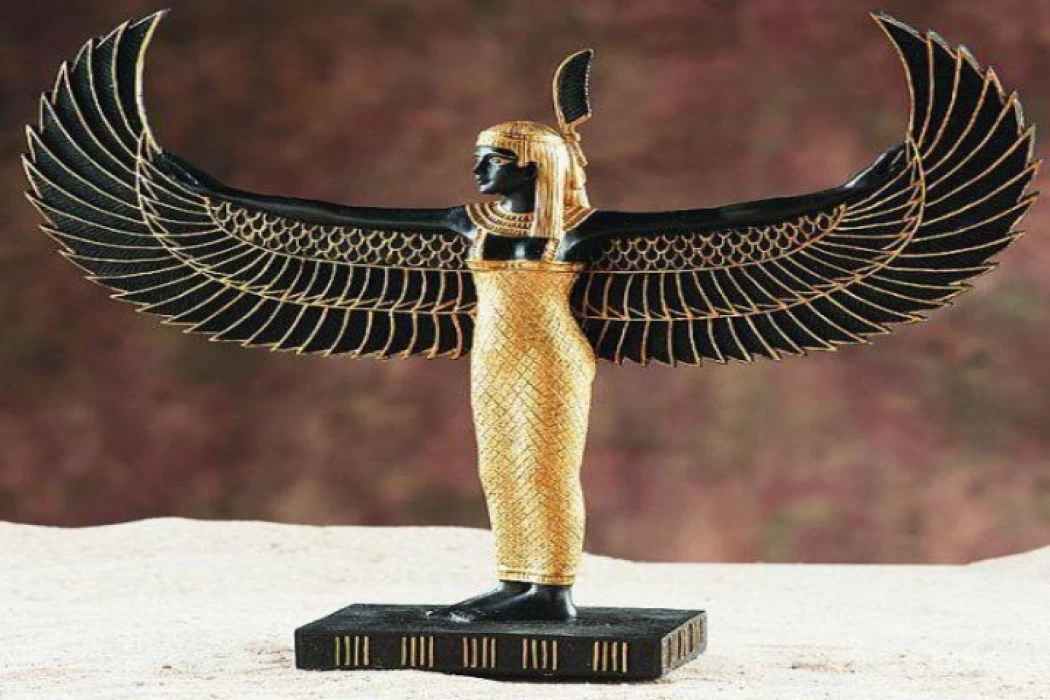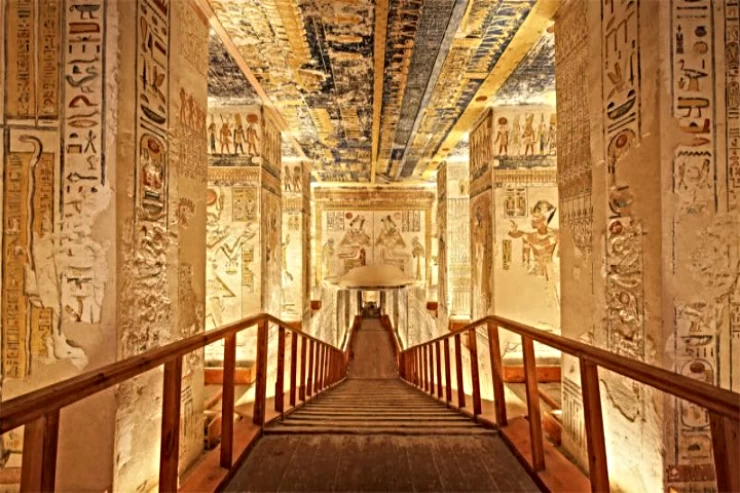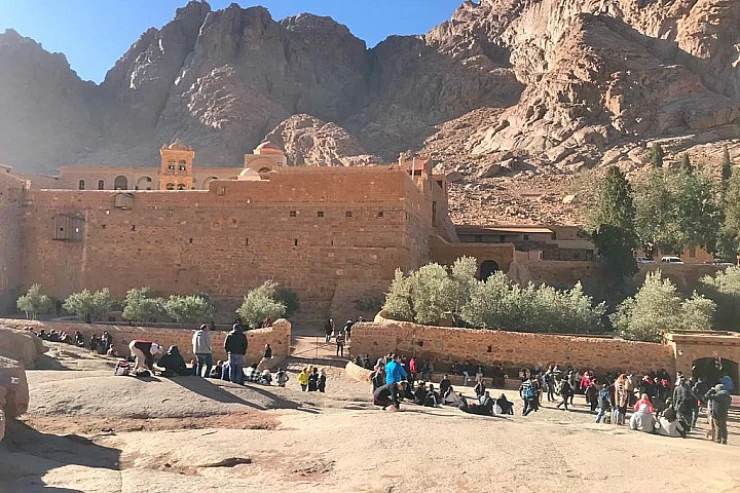
Diosa Ma`at en el Antiguo Egipto
Diosa Ma`at según la antigua religión egipcia ella es una diosa de la verdad y la justicia, Ma`at es la hija del dios Re y esposa de Thout dios del conocimiento La diosa Ma`at representada en forma de mujer con plumas de avestruz sobre sus cabezas y sosteniendo el Ankh que significa la llave de la vida y la otra mano sosteniendo la maza
En el inframundo de los antiguos egipcios, el corazón de los muertos se colocaba en las escamas de un lado y la pluma de la diosa Maat en el otro. Si el corazón del difunto se inclinaba, entraría en el Paraíso en sus creencias, pero si la pluma se hinchaba, entraría en el Infierno, que estaba representado por las antiguas creencias egipcias en la forma de un monstruo depredador imaginario llamado Amamut, cuya cabeza es la cabeza de un cocodrilo y su cuerpo es el cuerpo de un león y su espalda es el cuerpo de un hipopótamo. El tribunal en el inframundo constaba de 42 jueces, el número de regiones de Egipto, encabezado por Osiris.
La concepción de los antiguos egipcios en el Día del Juicio era que Anubis acompañaría a los muertos a la sala del tribunal, y los jueces comenzarían a interrogar al difunto sobre sus acciones en este mundo, y si estaba siguiendo el Maat (el camino correcto) o estaba él. entre los pecadores. Y el fallecido comienza a defenderse y dice: No maté a nadie, no expuse a una persona, y no me quejé de un trabajador con su patrón, y no robé. Y estaba alimentando a los pobres, y me dieron ropa a los desnudos, y ayudé a la gente, y solía dar agua a los sedientos. Entonces los jueces comenzaron a preguntarle sobre su conocimiento de los dioses, por lo que tuvo que mencionar a los dioses por sus nombres y tener cuidado de no olvidar a uno de ellos.
La ofrenda (Maat) es uno de los tipos de ofrendas más importantes y más importantes que los reyes estaban interesados en representar en los templos debido a su significado y gran importancia. El sacrificio de "Maat" confirma la misión del rey de lograr el orden (Maat) en la tierra y satisfacer a los dioses. [4]
El concepto de "Maat" era el sistema estándar exacto para todo lo que representa la base del mundo y todo lo que corresponde a los propósitos de la deidad creadora. Por lo tanto, es imperativo para los humanos preservarlos y aprobarlos, y restaurar "Maat" y el sistema a su condición adecuada si está expuesto a cualquier defecto o desorden. Y dado que la visión egipcia del maat como la esencia y el elemento material sobre el cual vive el mundo entero, y como un poder para los dioses y para los vivos y los muertos entre los humanos, los "Textos de los ataúdes" mencionaron que los dioses viven en (Maat) , y los dioses aprobaron "Maat" en la tierra, y su aprobación fue en La tierra es responsabilidad del rey, que representa a los dioses entre los hombres, y vive como él en (Maat).
La ofrenda de "Maat" resume en una forma simbólica fuerte todo lo que significa el culto y los sacrificios ofrecidos a los dioses, y todos los rituales del servicio diario en los templos y las ofrendas ofrecidas. Por lo tanto, un templo egipcio casi no está desprovisto de la escena del sacrificio del "Maat" en las diversas inscripciones, escenas religiosas y escenas de la ofrenda y los rituales.
Era necesario que el rey reconociera al "Maat" en la tierra, y esto se materializó en la presentación del rey de la ofrenda de "Maat" a los dioses como una metáfora para establecer el orden y la justicia, y lo que los dioses quisieran. El rey solía presentarlo diariamente a los dioses como prueba tangible de que era un representante de ellos en su oficio divino en el marco de (Maat).
El "sacrificio de maat" indica que la misión del rey es lograr el "maat", lo que significa que el sacrificio aquí es una metáfora o una expresión simbólica para completar la tarea de la que el rey es responsable. Aunque muchos textos indican que tanto los dioses como el rey reviven el "Maat" en el sentido moral más que en el sentido sacrificial, y que la deidad y el rey solo se alimentan del "Maat" como la verdad que se dice, y el justicia que se establece.
El sacrificio de Maat apareció desde el Reino Medio, aunque no apareció después hasta el reinado del rey Thutmosis III. La escena (la ofrenda del "Maat") se registró en las inscripciones de las paredes de la mayoría de los templos egipcios, y en ella se muestra al rey de pie frente a la deidad y le presenta el símbolo de "Maat" en su mano. , o en un barco. Y el sacrificio de "Maat" tendrá la forma de una pequeña estatua de la diosa "Maat", la diosa de la verdad, la justicia y el apretado orden cósmico, sentada con una pluma de "Maat" en la cabeza, y en su mano es el signo de la vida. En casos raros, encontramos la presentación de la pluma "Maat" únicamente, y eso fue en el templo de "Seboua" al rey "Ramsés II".
Entre los templos en los que apareció la escena del sacrificio de "Maat": el templo "Amun-Ra" en Karnak (en varias escenas del reinado del rey "Thutmosis III", frente a varias deidades); Y el templo "Aton"
Ma`at Goddess in Ancient Egypt
Goddess Ma`at according to ancient Egyptian religion is a goddess of truth and justice, Ma`at is the daughter of Re god and wife to Thout god of knowledge Ma`at goddess represented in women form with ostrich feather above her head and holding the Ankh which means the life key and the other hand holding the mace
In the underworld of the ancient Egyptians, the heart of the dead were placed on the scales on one side and the feather of the goddess Maat on the other side. If the deceased’s heart tilted, he would enter Paradise in their beliefs, but if the feather swelled, he would enter Hell, which was represented by ancient Egyptian beliefs in the form of an imaginary predatory monster named Amamut, whose head is the head of a crocodile and his body is the body of a lion and its back is the body of a hippo. The court in the underworld consisted of 42 judges, the number of regions of Egypt, headed by Osiris.
The 42 Laws of Maat: Ancient Egyptian Society's Ethical Underpinnings The fundamental tenets of justice and morality in ancient Egypt were established by the 42 Laws of Maat.
The conception of the ancient Egyptians on Judgment Day was that Anubis would accompany the dead to the courtroom, and judges would begin to question the deceased about his actions in this world, and whether he was following the Maat (the right path) or was he among the sinners. And the deceased begins to defend himself and says: I did not kill anyone, I did not expose a person, and I did not complain about a worker with his boss, and I did not steal. I was feeding the poor, and I was given clothes to the naked, and I helped people, and I used to give the thirsty water. Then the judges began to ask him about his knowledge of the gods, so he had to mention the gods by their names and beware of forgetting one of them.
To the pharaohs, Ma'at was represented as a goddess with an ostrich feather on her head, a symbol of justice. The goddess held the key of life, Menkh, in one hand and a scepter in the other, symbolizing balance. She was credited with controlling the seasons and the movements of the planets and stars.
The Cult of Maat
While the cult of Maat was more than limited, the respect she commanded was, however, boundless. For maat (justice) was always a cornerstone of social balance. Respect among humankind, in particular, ensured a measure of salvation. A salvation that Maat would appreciate during the final judgment rendered by Osiris. "To speak according to Maat" meant to speak the truth. At the Last Judgment, the heart spoke according to Maat and could not lie. Upon death, no deceased could avoid the trial of the Last Judgment.
There, the weight of good and evil accumulated in each person's heart was calculated. Thus, the deceased who had lived with justice and kindness would be assured of having their heart compared to Maat, to their advantage. It was during psychostasis (the "weighing of the soul") that everything concerning their future in the afterlife was decided. Maat as a principle was created to meet the complex needs of the emerging Egyptian state, which embraced diverse peoples with conflicting interests. The development of such rules sought to avoid chaos, and Maat became the basis of Egyptian legislation.
The concept of "Maat" was the exact standard system for everything, which represents the basis of the world, and everything that corresponds to the purposes of the Creator deity. Hence, it is imperative for humans to preserve and approve them, and to restore "Maat" and the system to its proper condition if it is exposed to any defect or disorder.
And since the Egyptian view of the maat as the essence and material element upon which the whole world lives, and as a power for gods and for the living and the dead among humans, the "Coffins Texts" mentioned that gods live on (Maat), and the gods approved "Maat" on earth, and its approval was on The land is the responsibility of the king, who represents the gods among men, and lives like it on (Maat).
















